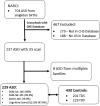Association between ultrasonography foetal anomalies and autism spectrum disorder
- PMID: 35037687
- PMCID: PMC9762947
- DOI: 10.1093/brain/awac008
Association between ultrasonography foetal anomalies and autism spectrum disorder
Abstract
Multiple pieces of evidence support the prenatal predisposition of autism spectrum disorder (ASD). Nevertheless, robust data about abnormalities in foetuses later developing into children diagnosed with ASD are lacking. Prenatal ultrasound is an excellent tool to study abnormal foetal development as it is frequently used to monitor foetal growth and identify foetal anomalies throughout pregnancy. We conducted a retrospective case-sibling-control study of children diagnosed with ASD (cases); their own typically developing, closest-in-age siblings (TDS); and typically developing children from the general population (TDP), matched by year of birth, sex and ethnicity to investigate the association between ultrasonography foetal anomalies and ASD. The case group was drawn from all children diagnosed with ASD enrolled at the National Autism Research Center of Israel. Foetal ultrasound data from the foetal anatomy survey were obtained from prenatal ultrasound clinics of Clalit Health Services in southern Israel. The study comprised 659 children: 229 ASD, 201 TDS and 229 TDP. Ultrasonography foetal anomalies were found in 29.3% of ASD cases versus only 15.9% and 9.6% in the TDS and TDP groups [adjusted odds ratio (aOR) = 2.23, 95% confidence interval (CI) = 1.32-3.78, and aOR = 3.50, 95%CI = 2.07-5.91, respectively]. Multiple co-occurring ultrasonography foetal anomalies were significantly more prevalent among ASD cases. Ultrasonography foetal anomalies in the urinary system, heart, and head and brain were the most significantly associated with ASD diagnosis (aORUrinary = 2.08, 95%CI = 0.96-4.50 and aORUrinary = 2.90, 95%CI = 1.41-5.95; aORHeart = 3.72, 95%CI = 1.50-9.24 and aORHeart = 8.67, 95%CI = 2.62-28.63; and aORHead&Brain = 1.96, 95%CI = 0.72-5.30 and aORHead&Brain = 4.67, 95%CI = 1.34-16.24; versus TDS and TDP, respectively). ASD females had significantly more ultrasonography foetal anomalies than ASD males (43.1% versus 25.3%, P = 0.013) and a higher prevalence of multiple co-occurring ultrasonography foetal anomalies (15.7% versus 4.5%, P = 0.011). No sex differences were seen among TDS and TDP controls. ASD foetuses were characterized by a narrower head and a relatively wider ocular-distance versus TDP foetuses (ORBPD = 0.81, 95%CI = 0.70-0.94, and aOROcular distance = 1.29, 95%CI = 1.06-1.57). Ultrasonography foetal anomalies were associated with more severe ASD symptoms. Our findings shed important light on the multiorgan foetal anomalies associated with ASD.
Keywords: autism spectrum disorder; congenital anomalies; foetal anatomy survey; foetal development; prenatal ultrasound.
© The Author(s) 2022. Published by Oxford University Press on behalf of the Guarantors of Brain.
Figures


Comment in
-
Methodological drawbacks in the alleged association between foetal sonographic anomalies and autism.Brain. 2022 Oct 21;145(10):e90-e91. doi: 10.1093/brain/awac246. Brain. 2022. PMID: 35802022 No abstract available.
References
-
- Battle DE. Diagnostic and statistical manual of mental disorders (DSM). CoDAS. 2013;25:191–192. - PubMed
-
- Mannion A, Leader G. Comorbidity in autism spectrum disorder: A literature review. Res Autism Spectr Disord. 2013;7:1595–1616.
-
- Sigmon ER, Kelleman M, Susi A, Nylund CM, Oster ME. Congenital heart disease and autism: A case-control study. Pediatrics. 2019;144:e20184114. - PubMed
-
- Wier ML, Odouli R, Yoshida CK, Grether JK, Croen LA. Congenital anomalies associated with autism spectrum disorders. Dev Med Child Neurol. 2007;48:500–507. - PubMed

